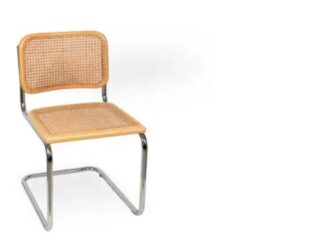
Few pieces of furniture possess the ability to effortlessly blend timeless design with versatile functionality like the iconic Breuer Cesca Chairs. Initially designed in 1928 by Marcel Breuer, these masterpieces of modernist design continue to captivate homeowners, designers, and collectors alike. Their minimalist frame, caned seat, and backrest are more than mere components of a chair; they are expressions of an era, a statement of form meeting function, and a testament to the Bauhaus philosophy.
Breuer Cesca Chairs have the unique power to transform a space from ordinary to extraordinary. Whether placed around a dining table, used as an accent in a living room, or integrated into a contemporary office setting. Their elegant yet approachable aesthetic enhances the character of any room, making them a true design classic that endures across generations.
A Timeless Design That Transcends Trends
The Cesca Chair’s silhouette is unmistakable: a cantilevered tubular steel frame supporting a woven cane seat and backrest, seemingly defying gravity. This radical departure from traditional four-legged chairs was revolutionary in the late 1920s, and it remains just as striking today. The seamless marriage of industrial materials with artisanal craftsmanship embodies a rare harmony—where the cold precision of steel meets the organic warmth of natural cane.
Unlike many design trends that fade with time, the Cesca Chair has an enduring appeal that effortlessly bridges past and present. Whether placed in a modern loft, a rustic farmhouse, or a bohemian retreat, the Cesca lends an air of sophisticated nonchalance. Its form is not just functional but sculptural, transforming any room into a curated space imbued with character and narrative.
Versatile Styling for Diverse Aesthetic Narratives
The Cesca Chair’s adaptability is one of its most compelling traits. It acts as a chameleon in interior design, seamlessly integrating into a multitude of aesthetic styles. In minimalist spaces, its sleek lines echo the principles of restraint and clarity, while in maximalist interiors, it provides a grounding element—an understated frame that balances visual complexity.
Pair a set of Cesca Chairs with a rustic farmhouse table, and the contrast creates a dynamic tension that is as compelling as it is harmonious. In a mid-century modern living room, a single Cesca chair can serve as a sculptural focal point, its airy form providing a moment of visual respite. The chair’s natural caning introduces an element of organic texture that softens the often harsh lines of contemporary architecture.
A Nod to Craftsmanship and Authentic Materials
At its core, the Cesca Chair is a celebration of honest materials and masterful craftsmanship. The cane weaving, traditionally handcrafted, introduces an artisanal touch that speaks of tradition and meticulous attention to detail. Each chair tells a story not just of its design lineage but of the human hands that wove its delicate patterns.

The tubular steel frame, polished to a luminous sheen, reflects light and adds a subtle gleam to a space. It also serves as a reminder of the industrial advancements that enabled such radical design experimentation in the early 20th century. By incorporating a Cesca Chair into a room, you are not merely placing furniture—you are inviting a conversation between tradition and innovation.
Elevating the Atmosphere of Any Room
The Cesca Chair does more than occupy physical space; it shapes the mood and atmosphere of a room. In a dining area, a set of Cesca Chairs fosters an inviting, convivial atmosphere where design is not just admired but lived. In a reading nook, a single Cesca creates a sense of curated calm, a place where the mind can wander and the eye can rest.
Moreover, the chair’s airy profile contributes to a sense of openness, making it ideal for small spaces where visual clutter can be overwhelming. Its transparency allows light and air to flow freely, creating an impression of spaciousness without sacrificing comfort or style.
A Lasting Investment in Design Heritage
Owning a Cesca Chair is more than an aesthetic choice—it is an investment in design history. This chair has earned its place in museums and design anthologies, revered not only for its form but for the ethos it represents: that design can be both beautiful and accessible, radical yet enduring.

Whether you are a seasoned collector of design classics or simply seeking to imbue your home with a touch of thoughtful character, the Cesca Chairs offers an unmatched blend of form, function, and narrative. It is a chair that transcends its utilitarian purpose, becoming a symbol of creative vision and timeless appeal.
In any room, in any setting, the Breuer Cesca Chair adds not just a seat, but a story—a subtle yet profound statement of how design can elevate the everyday into the extraordinary.






